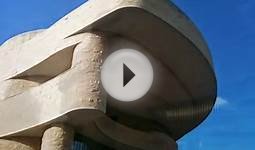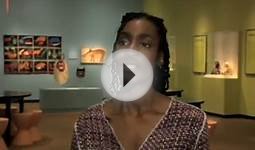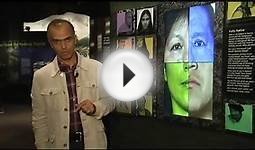African American Museum in Washington DC

- An architectural rendering of the Smithsonian's National Museum of African American History and Culture, which is expected to open on the National Mall in Washington, D.C., in 2015.
 Courtesy Freelon Adjaye Bond/SmithGroup/Courtesy of the National Museum of African American History and Culture
Courtesy Freelon Adjaye Bond/SmithGroup/Courtesy of the National Museum of African American History and Culture - Harriet Tubman's ShawlHistorian Charles Blockson donated 39 items to the museum, including a shawl owned by Harriet Tubman, the well-known abolitionist and humanitarian.
Courtesy of the National Museum of African American History and Culture
- Child's PortraitMost images of African-Americans in the early 20th century are portraits of poverty. Museum director Lonnie Bunch came across a remarkable collection of "cabinet cards" — portraits of middle-class blacks who were otherwise "invisible to most people."
Courtesy of the National Museum of African American History and Culture
- A Bill Of Sale For A SlaveThis is the original receipt for a 16-year-old girl named Polly who was sold for 0. "What really hits me about this document is it starkly reminds us that these people were considered property, " Bunch says. "Suddenly you realize that this paper really is a way into the story of this woman's life."
Courtesy of the National Museum of African American History and Culture
- Leg ShacklesThese slave shackles were likely crafted in Africa rather than Europe because they are relatively cumbersome to close and open. Europeans would have instead closed the shackles with a padlock. The size of the shackle loops indicates they were used on legs rather than arms.
Courtesy of the National Museum of African American History and Culture
- Thomas H. Porter Slave ButtonsThomas H. Porter, a slave trader based in Barbados, sold slaves along the coasts of Alabama, Louisiana, Mississippi, Georgia and the Carolinas, circa 1815-1830. He attached these buttons to the enslaved person's clothing during auctions.
Courtesy of the National Museum of African American History and Culture
- John Brown And Frederick Douglas LettersIn letters written to his wife while he was visiting Frederick Douglas, John Brown expresses his commitment to abolition, but also his longing to see her and his family. Douglas adds a greeting and reassuring words.
Courtesy of the National Museum of African American History and Culture
- Cross Burning In North CarolinaIn the early 1960s, University of North Carolina student Jim Wallace, who was not black, photographed a Ku Klux Klan rally and cross burning to document what he thought was a great evil, Bunch says.
 Courtesy of the National Museum of African American History and Culture
Courtesy of the National Museum of African American History and Culture - Glass Shards And Shotgun ShellJoan Trumpauer Mulholland gathered these artifacts from the gutter outside the 16th Street Baptist Church in Birmingham, Ala., during the funeral of the young girls killed in the 1963 bombing. Mulholland, a member the Student Nonviolent Coordinating Committee during the '60s, donated several objects to the museum.
Courtesy of the National Museum of African American History and Culture
- A Sign About Care At A Louisiana HospitalA carefully hand-lettered sign that once hung at the Lallie Kemp Charity Hospital in Independence, La., delineates the days "colored" patients could receive medical services.
Courtesy of the National Museum of African American History and Culture
- J.C. Deagan Chicago Vintage Railroad Dinner Bell ChimesEmployment as a railroad porter was considered one of the most stable and prestigious occupations open to African-Americans during the early- and mid-20th century. This engraved dinner chime was presented as a retirement gift to Leo LaRue, a porter who served executives for the Atchison, Topeka and Santa Fe Railroad in the 1960s and '70s.
Courtesy of the National Museum of African American History and Culture
- Bo Diddley's HatBo Diddley was born in McComb, Miss., in 1928 and became one of rock music's principal architects in the 1950s.
Courtesy of the National Museum of African American History and Culture
- Cassius Clay's Head ProtectorThis is an Everlast head protector from the 5th Street Gym in Miami, where Clay trained for his first fight with Sonny Liston. "As soon as he defeated Sonny Liston, he announced that he became a member of the Nation of Islam, became Muhammad Ali, " Bunch says.
Courtesy of the National Museum of African American History and Culture
- "Whether your family's been in this country 200 years or 20 minutes, " Bunch says, "I want you to come to this museum and say, 'I get it. This is not a black story. This is my story. This is the American story.'" Above, an architectural rendering shows the interior of the museum.
Courtesy Freelon Adjaye Bond/SmithGroup/Courtesy of the National Museum of African American History and Culture
President Obama spoke Wednesday at the formal groundbreaking for the Smithsonian's newest museum, the National Museum of African American History and Culture in Washington, D.C. The museum, Obama said, has been "a long time coming" and will serve "not just as a record of tragedy, but as a celebration of life."
Harriet Tubman's hymnal — with her name written on the inside cover — "is one of the great treasures of the museum, " says director Lonnie Bunch. Courtesy National Museum of African American History and Culture hide caption
itoggle caption Courtesy National Museum of African American History and CultureCourtesy National Museum of African American History and Culture
Obama said he hopes visitors will see the artifacts of the African-American experience and understand that "ordinary Americans could do extraordinary things" — whether they are inspired by Louis Armstrong's trumpet, the plane flown by Tuskegee Airmen or Harriet Tubman's shawl.
Museum director Lonnie Bunch remembers seeing a photograph of Tubman wrapped in the shawl two days before she died. The shawl was a gift from Queen Victoria, who had heard about the escaped slave who had freed so many other African-Americans that she earned the nickname "Moses."
The museum's collection also includes Tubman's hymn book, which she had for 50 years, using songs to alert slaves that it might be time to flee. "The rivers and creeks and streams played a vital role in the Underground Railroad, " says historian Charles Blockson.
References to those waterways were coded into spirituals: "Wade in the water. God's gonna trouble the water. The water, the underground, the flow ... her spirit is flowing into the National African American Museum, " he says.
When Tubman died in March 1913, her friends gathered at her bedside to sing her favorite spirituals. Blockson says he was touched by the hymnal of this spiritual woman: "They said that she was illiterate, but she attempted to write her name in the book."
Blockson donated 39 items that belonged to Tubman to the museum. Tubman's great-great niece, Mariline Wilkins, left the objects to him in her will. Their families, he says, have a connection. "Several of my relatives from the Eastern Shore of Delaware and Maryland escaped with Harriet Tubman, " he says.
The collection includes artifacts ranging from Tubman's homemade knife, fork and spoon to photographs from her funeral.
Visitors to the museum, which is expected to open in 2015, will also see shards of brightly colored glass from the 16th Street Baptist Church in Birmingham, Ala., where four little African-American girls were killed in a Ku Klux Klan bombing. But the items the museum has been collecting since 2005 also include Louis Armstrong's trumpet, funkmaster George Clinton's iconic stage prop the Mothership, a Jim Crow railroad car, and a Tuskegee airman bi-plane from World War II.
"That's the greatness of this museum, " says Tony Award-winning actress Phylicia Rashad, who was the master of ceremonies for the groundbreaking. It is important to know that the sum of the history of African-Americans is not encompassed by bondage and segregation, she says. "African-American people have contributed much to American culture: in medicine, in education, in art, in music, in dance. Name someplace where we have not been!"
President Barack Obama and first lady Michelle Obama attend the museum's groundbreaking ceremony. "This day has been a long time coming, " Obama said. Susan Walsh/AP hide caption
toggle caption Susan Walsh/APPresident Barack Obama and first lady Michelle Obama attend the museum's groundbreaking ceremony. "This day has been a long time coming, " Obama said.
You might also like












